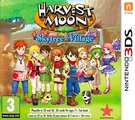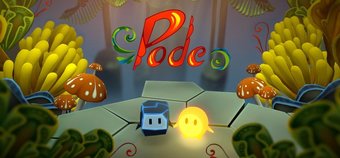It's no secret that we're big fans of Harvest Moon at Everybody Plays - the long-running, cutesy farming series has been hitting up consoles for the best part of the past two decades, and has ended up soaking up way too much of our spare time in the process. Still, it's fair to say we've been a little more lukewarm towards the series in recent years, as in 2014, Harvest Moon as we knew it changed, with publisher Natsume splitting from long-running developer Marvelous Interactive, in a messy divorce that made the series a whole lot more confusing.
With Natsume keeping the rights to the title and starting to make their own games under the Harvest Moon moniker, whilst the folks at Marvelous split off to start making Story of Seasons instead (which are essentially Harvest Moon games in all but name), it's been a confusing old time for fans, to say the least. And so now we arrive at the second of the 'new' Harvest Moon series, Harvest Moon: Skytree Village - and having fallen off the Harvest Moon/Story of Seasons bandwagon since the split, we'll admit we had no idea what to expect going in. Well, except plenty of farming anyway.
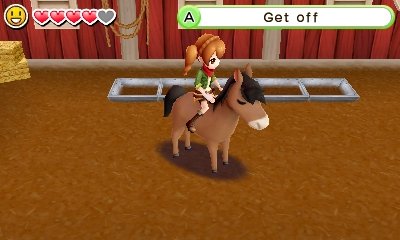
Look at my horse! My horse is amazing!
Sticking firmly with its tradition, Harvest Moon: Skytree Village begins in much the same way as every other entry so far, with an aimless protagonist stumbling onto an ailing kingdom, and deciding to farm it into prosperity once more. To the surprise of no-one, the titular Skytree Village is a desolate and deserted land, with all the inhabitants having up and moved away. Recruited by the local Harvest Goddess, you're drawn into a mission to help fix her ailing kingdom in the only way you know how - by farming furiously until the land's fertility returns. As you work, more and more people will stop by and take up residence in the town, restoring the people's faith in the Goddess, and reviving each of the powerful Skytrees in turn, until Skytree Village has returned to its former glory. It's a relatively bare-bones tale to be honest, serving as little more than an excuse to get you toiling away, farming crops and forming friendships as you go - but at least it serves its purpose.

The protagonist seems to have oddly specific dreams too - if farming doesn't work out, she can always be a fortune teller...
Following the traditional 'slice of (farm) life' formula, the bulk of your time in Skytree Village is spent tending to your expanding plot of land - although as always, everything's handled in a thoroughly simplified way compared to real life. For crops, it's up to you to till the soil, plant seeds, water them daily, and harvest the resulting produce, while animal care is similarly simple: a blur of brushing, feeding, milking and shearing to keep your cows, chickens, horses and the rest in tip-top produce producing condition. Sure, it's repetitive, but it's also strangely satisfying, as you watch your strawberries grow from a few seeds to berries the size of your head in the space of a few days. The new Poitou Donkey, a hairy beast that looks like the result of a bizarre breeding program between troublesome pooch What-a-Mess and a donkey, is a nice little fellow too. Needless to say, there's a reason the series has endured as a staple of the farming genre for more than two decades, and Skytree Village wisely doesn't mess with the tried and tested tradition too much.
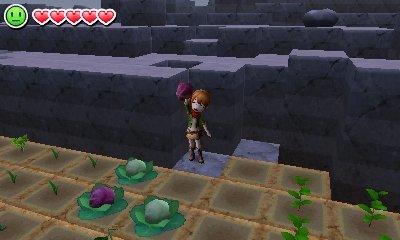
Harvesting cabbage after cabbage still requires a celebration, apparently.
However, the repetition goes a little bit further than before in Skytree Village - and that's not a good thing. For reasons known only to itself, the game has decided to drop any season-specific produce in favour of veg that'll grow pretty much all year around, taking out much of the time-management aspect that's been a staple for years. In the past, you'd need to do some quick mental maths to decide if you'd have time to plant some carrots towards the end of the season (if you didn't, your hard work would be for naught as the season changed over, as your crops would wither and die overnight), but now changing from spring to summer is really no more than a formality - those potatoes you planted on the final day of the month will be just fine. New seeds unlock as you play, but the fact you're growing the same crops all spring, summer, autumn and winter round does make farming feel more monotonous than usual, even if said crops now have a chance of growing into a rarer 'mutation', such as a red cabbage, white tulip or petite onion, which you can sell for more money at the store.
What Skytree Village does add to the proceedings, and what is pretty well done is its Minecraft-style terrain editing, which lets you contour your sprawling farmland however you see fit. Initially its weird rules can feel a bit confusing and restrictive - you're only able to dig down or raise up land by one block above or below your current position, and can only affect those bricks directly around the one you're standing on. You can't create any gravity defying structures and bridges, nor plonk down a huge tower of blocks under your feet should you find yourself stuck somewhere either. However, once you get your head around its little quirks, the terrain building is actually a pretty nice addition to the core Harvest Moon experience, especially as many of the aforementioned crop variants are more likely to pop up at various elevations, and in certain soil types and conditions. The 'Insta-Buildings' are a fun addition too, letting you pop down fully-formed barns, windmills and chicken coops wherever the mood takes you - and shuffle them around to better positions once your farmland expands over the course of the story.
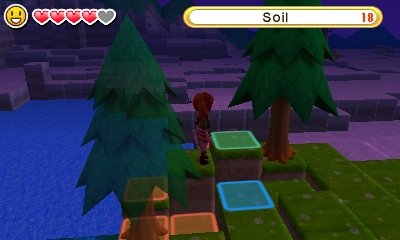
Figuring out the quirks of the terrain editing system can take some time...
Sadly, though, if there's a word that pops to mind with Skytree Village, it's probably bare-bones - the constituent parts of a Harvest Moon game are all present and correct, but it all feels somewhat soulless. At least part of the issue is that it doesn't feel like as much care has been taken with the game as usual - typos crop up in the things people say, while other lines are awkwardly phrased, or sometimes barely even make sense. Characters repeat themselves often when you chat to them, saying stuff that doesn't really fit with the current time of day, perhaps pining for their midday meal at 5pm in the evening, or wittering on about losing their way on 'this vast plot' of a farm you have whilst standing in the middle of town, about as far from your farm as its possible to get. Further adding to the rushed feeling of the game, many of the occupations listed for each of the town's inhabitants in the menu are totally wrong - a florist listed as a blacksmith's son, a doctor as a florist's daughter and the town shop keep as a blacksmith.
Gifts have been ditched too, in favour of a requests system that sees you fetching fish, growing greens and sheering sheep for the townsfolk, boosting their affection that way instead. On the plus side, it does mean you're never really short of things to do, always having a good few requests on the back burner at once. However, particularly in the case of the fishing requests, they can turn out to be more of a headache than they're worth, as folks always seem to want the rarest fish going - we spent months searching on a pretty much daily basis for a couple of elusive Tilapia for the innkeeper's daughter Elise, and almost a hundred Perches later, we still have only one. There's no easy way to find out which fish appear when or where - except Perches which seem to be ruddy every dang where - leaving you frustratedly fishing aimlessly, cursing whoever gave you the request.
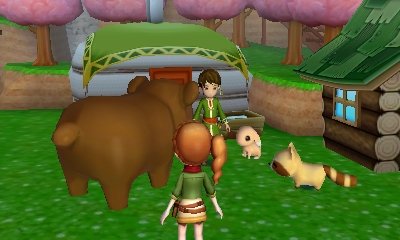
Can't help feeling like we're interrupting something here...
For all the ranting though, Harvest Moon: Skytree Village isn't a particularly bad game per se - just not up to the usual Harvest Moon standard. There's some interesting new additions, like the Minecraft-style terrain editing, and the never-ending requests from the villagers are sure to keep you busy outside of the daily farm work, while the traditional farming formula remains as solid as ever. However, a number of issues and strange decisions mar the whole experience, giving the impression that Skytree Village was a bit of a rushed project, missing out on some of the addictive magic we've come to know and love from the series, making the game a bit of a mixed bag.
Format Reviewed: Nintendo 3DS


